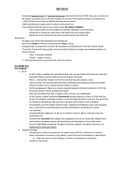500-750 CE
- Continued imperial crisis and political fracturing produced by the fall of WRE, Han and Jin, failure of
the Guptas to preserve power and the struggle for survival of the Eastern Romans and Sasanians.
=> Most of the EH was beset by fighting between lesser powers.
- Volkerwanderung brought greater Eurasian interconnection
- This continued due the rise of a new major power the Islamic Caliphate
- Also a minor player on the fringes that suddenly exploded to pre-eminence.
- Conquered an immense realm faster and larger than any empire before.
- Diplomatic and commercial networks spanned almost the whole EH.
Meanwhile:
- Struggle of survival of the Sasanians and Byzantines
- Rise of the Franks in Western Europe and the Tang in China
- Complete lack of cooperation between the Sasanians and Byzantines to halt the Arabian threat.
- The Arabs, Franks and Tang quickly renounced their barbarian heritage and adopted traditions of
earlier cultures.
- Tang -> heavenly mandate
- Franks -> legacy of Rome
==> Old imperial practices persisted, but with new powers.
The Middle East
The Caliphate
● Birth
○ In 497 in Mecca, Hashim ibn Abd Manaf died, who was the leader of the Quraysh tribe that
dominated Mecca and the trade across the Arabian Peninsula.
○ Mecca - strategically located: not far from the Red Sea and caravan routes.
○ After his death, the Quraysh preserved their dominance by promoting harmony between
tribes torn apart due to commercial and religious conflict.
○ But the emergence of Mecca as a minor regional hegemon attracted suspicion. In 570, the
(Christian) king of Yemen attacked and failed.
○ After the intertribal Fijar War, ‘a league of the virtuous’ was established.
○ In this context, Manaf’s grandson Muhammad started to preach in favor of Allah and the
umma. His religious teachings sought to unite the deeply divided society, but was perceived
as a threat by the Meccan elite and was countered with violence. Fled to Medina.
○ From Medina, his new religion spread: Islam. Adopted by the Medina clans and translated
into a constitution, prescribing peace between all Muslims and kindness towards
non-believers.
○ Amassed Muslim adherents. In 631, he was able to march to Mecca with his army and
capture the city.
○ Succeeded by Abu Bakr (first caliph) who subjugated most of the Arab tribes (Ridda Wars)
and initiated campaigns against the Byzantines and Sasanians to seize trade routes.
○ Second caliph Umar conquered Ctesiphon (Sasanian capital), Jerusalem, Damascus, ao.,
shattering the Sasanian Empire.
● Imperial ideology
○ Compassion for believers, protection for subservient believers, retribution to resisters.
○ Umar: advised his successors to live oberly, respect the law (no decadence or absolutism)
■ Imposed a pact on non-Muslims: security in exchange for submission.
○ Creation of the Quran
, 500-750 CE
● Umma was ripped apart by the strains and spoils of the conquests, sparking a civil war: division into
Shia and Sunni Muslims
○ Dividing line was the Euphrates: Shias in the east, Sunnis in the West.
○ The Sunni Umayyad clan prevailed, proclaiming a new caliphate in 661: Umayyad Caliphate
○ => The centre of Islamic power shifted from Mecca to the Levant, to Damascus.
● Umayyad Caliphate
○ Political organisation: appointed governors, ministries, a single currency, promoted Arabic as
common language.
○ Continued the relentless expansion
■ To bolster prestige, but also to avoid internecine fighting between Arab tribes, and to
take over Byzantine trade in the Med.
● Built a navy
● Suffering by Med peoples during the Muslim conquests.
● The successes of the caliphate were to a great extent due to failings of its enemies
○ Byzantine ineptitude: inability to cooperate with the Sasanians.
● ==> This antagonism between the Byzantines and Sasanians shaped the political situation in the
Eastern Med and ME.
○ Overlapping SOI in Armenia and the Caucasus.
■ Both vied to control a region that acted as a buffer between them and against the
steppes peoples of CA. Security dilemma: one side fortifying its borders provoked the
other.
■ Justinian the Great constructed a fortress on the border in northern Meso.
Sasianians forbade further construction. Diplomatic attempts collapsed into a
full-scale war.
○ Also friction over the Himyar-Aksum conflict
■ Himyar called on the Sasanians for support. Aksum was backed by Constantinople.
○ Proxy wars fought by the Lakhmid and Ghassanid kingdoms
○ Conflict over silk trade
■ Justinian sought to bypass Sasanian control over the Silk Road by directly trading
with Arab kingdoms via the Red Sea.
○ 532: eternal peace treaty between Justinian and Khosrow I
■ Constantinople paid a large sum for this treaty, being under barbarian pressure from
the north.
■ Didn’t last
○ 562: a fifty-year peace prohibited fortress building in Armenia, among other things.
○ 591: another eternal peace signed, but another war erupted notwithstanding.
■ Sasanians advanced into the Byzantine Empire, besieged Constantinople (626).
■ But under Emperor Heraclius, the Byzantines retaliated, regained Constantinople.
○ 628: Sasanians sued for peace.
● => The endless wars weakened both empires and made them dependent on frontier kingdoms for
defense.
○ Couldn’t even cooperate when the Muslims started conquering.
● The Sasanians and Byzantines both had considered themselves the defender of the true faith.






